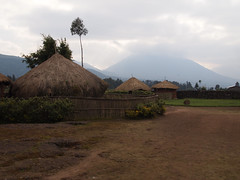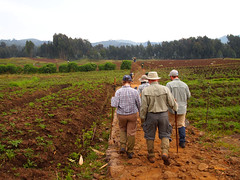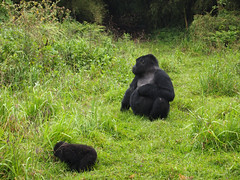Some folks ask “how is it that you do a mountain gorilla trek?” Now that I have done, well, let's see. Counting all of the times that I have been out on the trail trying to find a or more than a gorilla. And adding in all the other times I looked to see if I could find a gorilla. Well, turns out only once. Thus, this is the only time. Doesn't make me much of an expert, seems to me. Even so, here are my thoughts.
First you need to go to some serious volcano country. North Rwanda suits the bill. Note the slope on that mountain. Seems like a volcano to me.
Your guide will tell you which gorilla family you get to visit. These guys do know their stuff, and the planning is well done. There are trackers in the bush all the time to ensure they know where the gorilla families are, thus minimizing the time the tourists need to spend in the bush.
To set the context:
In Virunga each day there are about eight to ten groups of eight trekkers (really tourists–the whole scene made me think of a combined LL Bean and Eddie Bauer convention) who each pay $500, recently raised to $750–my math puts that at more than $30,000 a day;The deal is that each gorilla family only has to endure human contact for one hour per day–that is all the time you get watching the gorillas–and I can bet they do not want any more time with you;Dian Fossey was murdered in 1985 (her head chopped with a machete she had confiscated from a poacher and had placed on the wall of her cabin in Rwanda);Many people in Rwanda were not happy with Ms. Fossey's absolute view that the gorillas of Virunga should be left alone, otherwise they would perish once and for all;Who were the people who hated Ms. Fossey's protection of the gorillas: the Rwanda government, poachers, and zookeepers;Why is that?Leaving the gorillas alone and giving them a chance to survive would mean costs but no revenue;No revenue from the tourists;No revenue from the bush meat;No revenue from the capturing of baby gorillas to export to zoos (by the way, Ms Fossey documented situations where six to eight adult gorillas were shot when they tried to protect the abduction of their baby gorillas). Anyways, enough of the context, here's the guide explaining which family we get to visit:
Once you get the briefing and set out with your group, perhaps you will pass by a token “African village.”
Then you may have to walk through some farmland with guys that (for some reason) have been provided with walking sticks and leggings.
At some point your group will start to get into the jungle.
If you are lucky you will see an elephant. If you are unlucky an elephant will step on your foot. This is my foot and one of the tracker's foots beside an elephant footprint.
Eventually, you and your group will get into some pretty and serious jungle.
Finally, the trackers appear out of the bush to confirm where the gorillas are.
And, as if on cue, this is the first contact with two of my cousins (I think their names are Tim and Traci).
And finally, this is the big boss man coming in your direction. The biggest gorilla in Virunga, weighing in at 220 kilos (not that I saw him on a weigh scale or anything).
And here he is going in the other direction (the end).














